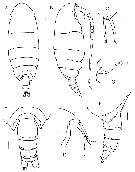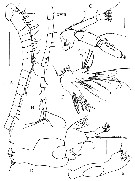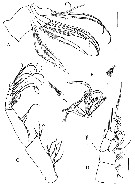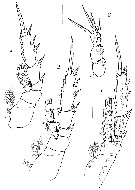|
|
 |
|
Calanoida ( Order ) |
|
|
|
Clausocalanoidea ( Superfamily ) |
|
|
|
Diaixidae ( Family ) |
|
|
|
Sensiava ( Genus ) |
|
|
| |
Sensiava peculiaris Markheseva, 2014 (F) | |
| | | | | | | Ref.: | | | Markhaseva, 2014 (p.228, Descr.F, figs.F); Laakmann & al., 2019 (p.330, fig. 2, 3, 4, phylogenetic relationships) |  Issued from : E.L. Markhaseva in Zootaxa, 2014, 3802 (2). [p.229, Fig.9]. Female (from G. of Guinea largo sensu): A-B, habitus (dorsal and lateral, respectively); C, rostrum (dorsal view); D, same (lateral); E-F, posterior prosome and urosome (dorsal and lateral, respectively); G, genital field (lateral view). Scale bars: A-B, 0.5 mm; C-H, 0.1 mm. Nota: Prosome 3.7-4.1 times as long as urosome. Rostrum as 2 filaments. Cephalosome and 1st pedigerous somite invompletely separate, 4th and 5th completerly separate. Posterior corners of prosome in dorsal view trianguylar; as short rounded in lateral view. Urosome of 4 somites. Spermatheca elongate, narrow and rounded distally, directed anteriorly. Caudal rami with 1 dorsal, 1 ventral and 4 terminal setae.
|
 Issued from : E.L. Markhaseva in Zootaxa, 2014, 3802 (2). [p.230, Fig.10]. Female: A, A1, articulating segments 1-14 (ancestral segments I-XVII); B, same, articulating segments 15-24 (ancestral segments XVIII-XXVIII); C, A2; D, Md; E, Md gnathobase; F, Mx1 (arrow marks distalmost terminal seta curved at the apex). Scale bars: 0.1 mm. Nota: A1 nearly as long as body, or reaching to caudal rami, of 24 articulating segments. Md: gnathobase without crest, cutting edge with 5 large and 3 small teeth near dorsal seta; basis with 3 setae; exopod 5-segmented with setal formula 1, 1, 1, 1, 2; endopod segment 1 with 2 setae, segment 2 with 9 setae. Mx1: praecoxal arthrite with 9 marginal, 3 posterior and 1 anterior setae, distalmost praecoxal arthrite terminal seta curved at apex; coxal endite with 4 setae; xoxal epipodite with 7 long and 1 short seta; proximal basal endite with 4 setae, distal basal endite with 4 setae; endopod with 9 (3+6) setae; exopod with 8 setae.
|
 Issued from : E.L. Markhaseva in Zootaxa, 2014, 3802 (2). [p.231, Fig.11]. Female: A, Mx2 (sensory setae of endopod are not figured); B, Mx2, sensory setae of endopod; C, Mxp; D, P1. Scale bars: 0.1 mm. Nota: Mx2: praecoxal endite (anteriorly as proximal praecoxal endite) with 4 setae and 1 small attenuation; coxal endite (anteriorly as distal praecoxal endite) with 3 setae; basal endites (anteriorly as coxal endites) with 3 setae each, 1 seta of proximal basal endite sensory, worm-like; enditic-like lobe of proximal endopodal segment (anteriorly as proximal basal endite) with 4 setae (2 sensory and worm-like); setae of the maxilla basal endites and enditic-like lobe of endopod are similar in shape and size, curved distally: endopod with 3 worl-like and 5 brush-like sensory setae.
Mxp: syncoxa with 1 sclerotized seta on proximal endite, 1 worm-like and 1 sclerotized setae on middle praecoxal endite and 2 sclerotized and 1 worm-like setae on distal praecoxal endite; coxal lobe with 3 setae. Basis with 3 proximal setae and 2 distal setae. Endopod 5-segmented with setal formula 4, 4, 3, 3+1, 4.
|
 Issued from : E.L. Markhaseva in Zootaxa, 2014, 3802 (2). [p.2232 Fig.12]. Female: A, P2; B, P3; C, P4; D, P5. Scale bars: 0.1 mm.
| | | | | NZ: | 1 | | |
|
Distribution map of Sensiava peculiaris by geographical zones
|
| | | | Loc: | | | S Atlantic (equatorial)
Type locality: 00°01'S, 02°29'W. | | | | N: | 1 | | | | Lg.: | | | (1171) F: 2,80-3,0; {F: 2,80-3,0} | | | | Rem.: | hyperbenthic (above sea bed at abyssal depths 4602 -5430 m) | | | Last update : 02/04/2019 | |
|
|
 Any use of this site for a publication will be mentioned with the following reference : Any use of this site for a publication will be mentioned with the following reference :
Razouls C., Desreumaux N., Kouwenberg J. and de Bovée F., 2005-2025. - Biodiversity of Marine Planktonic Copepods (morphology, geographical distribution and biological data). Sorbonne University, CNRS. Available at http://copepodes.obs-banyuls.fr/en [Accessed November 30, 2025] © copyright 2005-2025 Sorbonne University, CNRS
|
|
 |
 |







